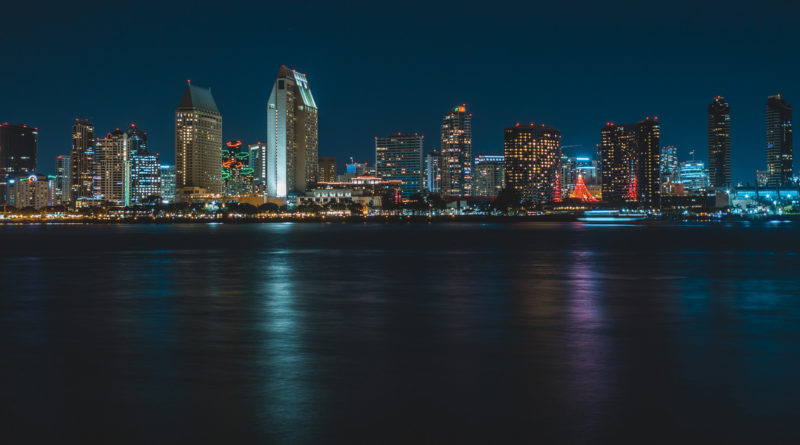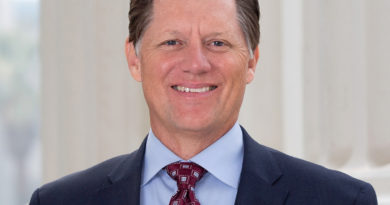Golden San Diego
In Top Gun: Maverick, the 2022 sequel to the movie Top Gun, Tom Cruise reprises his role as the raffish fighter pilot who stole both his instructor’s heart and America’s back in 1986. Joining Cruise’s Maverick is not Anthony Edwards’s Goose (long gone) or Val Kilmer’s Iceman (a mere cameo) but the original film’s true costar: the city of San Diego.
From its shots of the clear skies over Naval Air Station Miramar to the breathtaking ocean views at Point Loma to the city’s beachside Craftsman houses, the original movie’s portrayal of San Diego reflected California’s status as a global icon. The city was youthful, brash, optimistic, and thoroughly American—a testament to the nation’s late–Cold War confidence. Thirty-six years later, Maverick again hits the sand, races his Kawasaki motorcycle down the coast, and gets the girl. The sequel features a richer plot and more mature characters than did its predecessor, but San Diego remains just as romantic as the first time around. Director Joseph Kosinski set out to depict “the perfect version” of California, he told the press, replacing the orange haze of the original movie with Pacific Ocean blues and Torrey Pines greens. While the aesthetic has evolved, the city’s patriotism, celebration of martial competence, and positive spirit persist.
These days, however, the country finds itself on less stable footing. Rather than awaiting the crack-up of a geopolitical rival, it is watching a new one consolidate power. The idea of a presidential candidate from either party tallying 500-some electoral votes, as Ronald Reagan did in 1984, is now unimaginable. And California itself has changed: its elections have become intraparty affairs, with zero Republicans winning a statewide race since 2006; its economy, while generating returns for the well-to-do, leaves many families struggling to afford homes. What was once the promised land for America’s middle class has become a site of mass exodus.
Yet Top Gun: Maverick’s portrayal of San Diego as an optimistic beacon turns out to be surprisingly accurate. The city isn’t free from difficulties, but it is better governed than its coastal counterparts. In San Diego, a multiethnic, civic patriotism flourishes alongside a relatively functional economy, making it the Golden State’s true standout city.
With a population of 1.4 million and a metro area total of 3.3 million, San Diego is unique among big American cities for its relationship with the armed forces. As home to more than 115,000 active-duty service personnel (and three active aircraft carriers), San Diego County boasts more military might than any other major metro area in the country. Defying California caricatures, San Diego is a city defined by pride in the red, white, and blue.
Marquee installations include the Miramar air station, now managed by the Marine Corps; Naval Air Station North Island, where the U.S. Pacific Fleet Naval Air Force is based; the sprawling Camp Pendleton, a Marine Corps base that separates San Diego from the outer reaches of the Los Angeles commuter region; Coronado Island’s vaunted Navy SEALs training ground; and the USS Midway aircraft-carrier museum, which brings tourists to the downtown waterfront and serves as a kind of city symbol.
The military presence buoys the city’s economy. In its 2022 Economic Impact Study, conducted with University of California–San Diego’s Rady School of Management, the San Diego Military Advisory Council estimated that more than 150,000 service members and civilians work for the Navy, Marine Corps, Reserves, Coast Guard, or Veterans Administration in San Diego County. According to the city’s annual financial report, defense-related activities and spending generate approximately $55 billion of gross regional product for San Diego County, 25% of the region’s total. Directly or as a result of defense contracts, the armed forces are responsible for an estimated 360,000 jobs in the region, or nearly 25% of total employment.
San Diego’s symbiotic relationship with the armed forces is perhaps best exemplified by General Atomics, a defense-technology company specializing in aerial-warfare products and surveillance. Among the county’s largest employers outside of government, education, and health care, General Atomics builds unmanned aircraft, high-powered lasers, and electromagnetic rail guns. It was founded in the 1950s as a division of General Dynamics and emerged as a key San Diego presence and partner of the armed forces by the end of the Cold War, when entrepreneur Neal Blue acquired its assets. For nearly two decades, Thomas J. Cassidy led a General Atomics affiliate that developed the Predator and Reaper drones, used extensively in America’s wars in Iraq and Afghanistan. In the 1980s, Cassidy was the commander of Naval Air Station Miramar and the Top Gun program, playing himself in the original movie. County records indicate that General Atomics employs about 6,500 San Diegans, continuing the city’s military-industrial tradition.
Qualcomm is another example of the city’s close ties with the military. Established in 1985, the firm built itself into a major national and international chip designer. Today, it is the largest public company headquartered in San Diego, developing technology for Samsung Galaxy smartphones and Meta’s virtual-reality headsets. After Congress passed the CHIPS and Science Act, President Joe Biden touted Qualcomm as among the firms increasing domestic investment.
San Diego has also become a magnet for venture capital. According to Pitchbook, the San Diego metro area ranked fifth in the United States in 2021 for total venture capital investment, at $9.6 billion, trailing only the Bay Area, New York, Boston, and Los Angeles. Biotechnology attracts much of these investments. Anchored by the life-sciences programs at UC–San Diego, the city’s La Jolla, Torrey Pines, and Sorrento Valley enclaves form a world-class research-and-development cluster. Such firms as Eli Lilly and BD Biosciences have set up West Coast facilities for pharmaceutical and immunology research in the city. Startups like the genomics company Replay, which develops technology platforms for gene and cell therapies, also contribute. Last summer, La Jolla–based firm National Resilience announced that it had raised $625 million in a Series D funding—adding to a previously unannounced $600 million Series C—to harden production and supply chains in biologics, vaccines, nucleic acids, and gene and cell therapies.
The biotech tilt is one reason that San Diego’s commercial real-estate sector has withstood the rise of remote work. Workers can code from a spare bedroom, but they can’t test drugs there. Last March, the San Diego Union-Tribune reported a scramble for office and lab space in the Sorrento Valley, which one financier called a “unique phenomenon.” At the time of the Union-Tribune’s reporting, office vacancy stood at about 11 percent in the city overall and under 8 percent in Sorrento Valley. The current rate in San Francisco, meantime, is 25 percent.
San Diego’s practical ethos reflects an economy based on applied science and technology. If Los Angeles depends on imagination and San Francisco on bits, San Diego remains immersed in the world of atoms—and is more resilient for it.
For an aviation hub, San Diego is rather down-to-earth. While San Franciscans sip biodynamic wine and Angelenos hunt for boutique cocktails, San Diego is a beer town. With more than 100 breweries scattered about the county, the drinking culture is varied without being pretentious, reinforcing the city’s common-man appeal.
No surprise, then, that compared with its California counterparts, San Diego is a paragon of political moderation. Since the turn of the millennium, San Diego County has voted for the winner in all but one presidential election. By comparison, Los Angeles County, San Francisco County, and Santa Clara County each voted for the Democratic Party candidate by 25 points or more each cycle. The city has become more Democratic since pulling the lever for George W. Bush twice—in 2016, San Diegans voted for Hillary Clinton by a 20-point margin—but support for Donald Trump was stronger in San Diego than in Los Angeles, San Francisco, and Santa Clara Counties, where the Republican lost by 43, 75, and 53 points, respectively, that year.
Though San Diego’s congressional, state, and local offices have also swung Democratic, voters still hew closer to the center. Scott Peters, San Diego County’s longest-serving Democratic congressman, has embraced the reborn “neoliberal” movement, promoting market economics, free trade, and relaxed housing regulations. Democratic state assemblyman Brian Maienschein, a longtime area pol, campaigned and legislated as a Republican for years before switching parties in 2019. While he criticized the trajectory of the national GOP, Maienschein remains a centrist, winning a closely contested battle for a redrawn district last November, while touting “endorsements from every major law enforcement organization in California” and opposing “new and higher taxes.”
Still, the city’s leftward shift is real. In the 2020 mayoral race to replace term-limited Republican Kevin Faulconer—the mayor who stood out for his party affiliation and remained popular for his pragmatism—Democrats finished first and second in a nonpartisan primary. Eventually, progressive Todd Gloria defeated Barbara Bry to earn the mayoralty. A precursor to 2020 was the 2018 defeat of Republican city councilmember Lorie Zapf. Zapf’s loss was the first for a city council incumbent since 1992, and it came by a margin of 16 points. In the telling of Scott Lewis, editor-in-chief for local nonprofit newsroom Voice of San Diego, these results reflect the crumbling of local Republican political infrastructure in the Trump era. The coda came in November 2022, when a Democrat was elected to the seat vacated by the final, term-limited city council Republican.
San Diego County of late has typified the “density divide” thesis, according to which higher-density places move to the left while lower-density areas shift to the right. Consider the odyssey of Republican congressman and former House Oversight Committee chairman Darrell Issa. He served nine terms representing a North County area that ranged from the coast to the mountains that divide the county, but he declined to run again in 2018 (Democrat Mike Levin won the district). In 2020, Issa reentered the fray but opted to compete in a less dense, more right-leaning district and won by 7 percentage points. And after redistricting in 2022, Issa won his district—now stretching from the city’s eastern suburbs over the mountains and deep into Southern California’s inland desert—by 20 points. With the city proper’s recent move left and the outlying areas’ rightward bent, San Diego’s voting patterns increasingly resemble those in other American metros.
“If Los Angeles depends on imagination and San Francisco on bits, San Diego remains immersed in the world of atoms.”
Where San Diego looks painfully Californian is in its housing costs. Kosinski’s sunny portrayal of the city in the Top Gun sequel may be accurate, but the lifestyle of one character strains credulity. Jennifer Connelly’s Penny Benjamin owns not only a bar off the training runway, which aviation insiders might recognize as a reproduction of the I Bar on Naval Air Station North Island, but also a house on the water. Yet two-bedroom houses on Coronado Island sell for well into seven figures: a house measuring just 804 square feet sold last October for over $1.8 million. Perhaps the house has been in the family for a while—Penny’s dad was an admiral name-dropped back in the original film—and thus enjoys the benefit of California’s Prop. 13 property-tax cap. But San Diegans watching the movie can’t help but laugh.
Many people would love to live on the Pacific Coast, but tax laws, zoning, and height restrictions mean that only a privileged few can. With house price-to-income ratios as high as in any city in the country, San Diego can be a hard place to find a home.
Relative to its California counterparts, though, San Diego is a housing-policy bright spot. Beginning under Faulconer and continuing under Todd Gloria, San Diego has been a state leader in permitting and land-use reform. Faulconer advanced, according to the Los Angeles Times in 2019, “some of the most aggressive strategies of any California city to promote apartment and condominium construction.” In 2017, 2019, and again in 2020, the city liberalized its policy on accessory dwelling units (ADUs), effectively making them legal in all single-family zones. According to Voice of San Diego, this boosted the number of new ADU builds from a combined total of 22 units in 2016 and 2017 to 492 units in 2019 and 2020, drawing Faulconer plaudits from across the country. “To actually move the needle in a significant way,” Faulconer told the Wall Street Journal, “you have to get government less involved in the production of housing, and take away the barriers.”
Under Gloria, the city has been granted a “pro-housing designation” by the state, the largest city to earn the tag. As the Times wrote in November 2022, “San Diego has dramatically outperformed its neighbors to the north.”
Like other coastal cities in California, San Diego has a problem with homelessness, despite its relatively pro-housing posture. During the Faulconer era, homelessness surged, culminating with a horrific hepatitis A outbreak in 2016 and 2017 that left 20 people dead. In the wake of that episode, the mayor launched a homelessness counteroffensive on what Voice of San Diego calls the Faulconer Doctrine: offering homeless San Diegans the choice of services and housing or consequences from police.
Evidence suggests that the approach was effective. According to San Diego’s Downtown Partnership, the number of “rough sleepers” in the commercial heart of San Diego declined steadily from a 2016 peak of 1,400 to early 2021, when fewer than 700 people were outdoors downtown each night.
Since 2021, however, the trend has reversed with stunning speed. By the beginning of 2022, the count stood again at 1,400; by November 2022, the most recent month the Downtown Partnership has on record, it had eclipsed 1,800. This explosion has cost Gloria the support of former allies like the city’s most famous hippie, basketball legend Bill Walton, who has castigated him publicly and called for his resignation.
While Gloria made a campaign vow to “stop criminalizing the existence of San Diego’s poorest and sickest residents,” he has now come around to the wisdom of the Faulconer Doctrine, directing police to offer shelter beds and to issue warnings, then citations, and finally to make arrests when needed.
Gloria deserves credit for changing tack and for resisting (even in 2020) the progressive defund-the-police ethos. Indeed, in 2022, Gloria proposed increases to the police budget, and in his January 2023 State of the City address, he emphasized the importance of law and order. He has also long championed conservatorship laws and California’s CARE Court legislation to address what he refers to as the state’s behavioral health crisis. As Manhattan Institute fellow Thomas Hogan has noted in City Journal, San Diego remains one of the safest cities in the U.S., keeping violent and property crime rare with sensible law-enforcement policies.
San Diego’s culture resonates with the American mainstream more clearly than those of its coastal counterparts. Yet the city also retains the qualities that once made California the envy of the world: openness to ideas, newcomers, and risk-taking, not to mention natural beauty. San Diego pairs the best attributes of the Golden State with the virtues of civic patriotism and moderation. Perhaps it can serve as a template for a renewal of the California dream.



